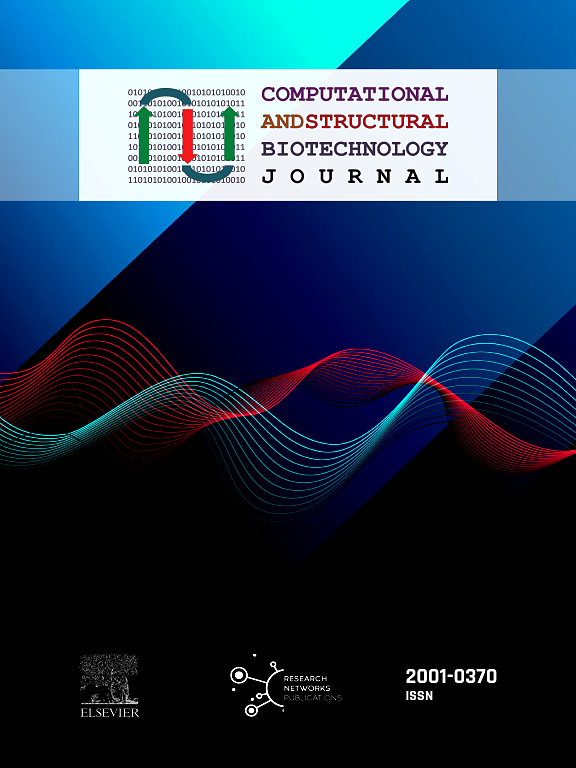从结构上洞察人类肽基精氨酸脱氨酶 6 的功能
IF 4.4
2区 生物学
Q2 BIOCHEMISTRY & MOLECULAR BIOLOGY
Computational and structural biotechnology journal
Pub Date : 2024-08-16
DOI:10.1016/j.csbj.2024.08.019
引用次数: 0
摘要
肽基精氨酸脱氨酶 6(PADI6 或 PAD6)对小鼠和人类的早期胚胎发育至关重要,但其功能仍然难以捉摸。与其他 PADIs 相比,PADI6 的保守性较低,目前尚不清楚它是否具有催化功能。在这里,我们发现人类 PADI6 与 hPADIs 2-4 一样具有二聚体,但不与 Ca 结合,而且在针对标准 PADI 底物的试验中没有活性。通过测定 hPADI6 的晶体结构,我们发现 hPADI6 是在没有 Ca 的情况下形成的,而 hPADI2 和 hPADI4 则不是,而且与 Ca 结合的位点也不是保守的。此外,我们还发现,虽然关键的催化天冬氨酸和组氨酸残基在结构上是保守的,但半胱氨酸却远离了活性位点中心,而且 hPADI6 的活性位点口袋似乎是通过一种独特的进化机制关闭的,这在其他 PADIs 中是不存在的。综上所述,这些发现让人们了解了 hPADI6 的功能是如何根据其结构而不同于其他 PADIs 的,并为鉴定具有临床意义的变异体的破坏作用提供了资源。本文章由计算机程序翻译,如有差异,请以英文原文为准。
Structural insight into the function of human peptidyl arginine deiminase 6
Peptidyl arginine deiminase 6 (PADI6 or PAD6) is vital for early embryonic development in mice and humans, yet its function remains elusive. PADI6 is less conserved than other PADIs and it is currently unknown whether it has a catalytic function. Here we show that human PADI6 dimerises like hPADIs 2–4, however, does not bind Ca and is inactive in assays against standard PADI substrates. By determining the crystal structure of hPADI6, we show that hPADI6 is structured in the absence of Ca where hPADI2 and hPADI4 are not, and the Ca-binding sites are not conserved. Moreover, we show that whilst the key catalytic aspartic acid and histidine residues are structurally conserved, the cysteine is displaced far from the active site centre and the hPADI6 active site pocket appears closed through a unique evolved mechanism in hPADI6, not present in the other PADIs. Taken together, these findings provide insight into how the function of hPADI6 may differ from the other PADIs based on its structure and provides a resource for characterising the damaging effect of clinically significant variants.
求助全文
通过发布文献求助,成功后即可免费获取论文全文。
去求助
来源期刊

Computational and structural biotechnology journal
Biochemistry, Genetics and Molecular Biology-Biophysics
CiteScore
9.30
自引率
3.30%
发文量
540
审稿时长
6 weeks
期刊介绍:
Computational and Structural Biotechnology Journal (CSBJ) is an online gold open access journal publishing research articles and reviews after full peer review. All articles are published, without barriers to access, immediately upon acceptance. The journal places a strong emphasis on functional and mechanistic understanding of how molecular components in a biological process work together through the application of computational methods. Structural data may provide such insights, but they are not a pre-requisite for publication in the journal. Specific areas of interest include, but are not limited to:
Structure and function of proteins, nucleic acids and other macromolecules
Structure and function of multi-component complexes
Protein folding, processing and degradation
Enzymology
Computational and structural studies of plant systems
Microbial Informatics
Genomics
Proteomics
Metabolomics
Algorithms and Hypothesis in Bioinformatics
Mathematical and Theoretical Biology
Computational Chemistry and Drug Discovery
Microscopy and Molecular Imaging
Nanotechnology
Systems and Synthetic Biology
 求助内容:
求助内容: 应助结果提醒方式:
应助结果提醒方式:


